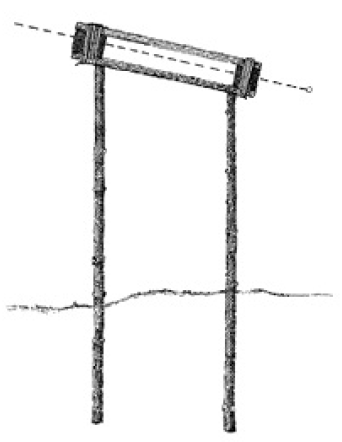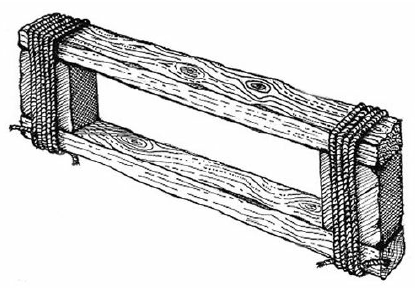|
APPENDIX ONE
USING THE MEGALITHIC PENDULUM
About Pendulums
A pendulum is one of the simplest devices imaginable. In its most
basic form it is nothing more than a weight suspended on a piece of
twine or sinew.
Since the pendulum has another function,
as a plumb line, it may well be one of the first devices used by
humanity. If allowed to hang, the weight of a pendulum will pull its
string into a perfectly vertical position. Certainly the Megalithic
people could never have constructed any of the major sites to be
found all over Britain, Ireland and Brittany without the use of this
device.
It is therefore reasonable to suggest
that if they possessed a plumb line, they also possessed a pendulum
.
Although the device had been around for a long time it was the
sixteenth-century genius Galileo who seem s to have been the first
person to look seriously at the attributes of pendulums (or at least
the first of whom we have a record.)
He is reported to have been bored in
Church one day when his attention was caught by a large incense
burner suspended from above by a chain or a rope, gently swinging
back and forth and forming a natural pendulum. Galileo realized that
the swings of the pendulum were equal in terms of time and he
counted them against the beat of his own pulse.
Only two factors are of importance in the case of a simple pendulum.
These are the length of the string and the gravitation of the Earth,
which constantly exerts a pressure that will eventually bring the
pendulum back to a vertical and resting position.
The height of the swing of a pendulum
is, to all intents and purposes, irrelevant because its time period
from one extremity to the other will always be the same. In other
words if the pendulum is excited more vigorously it will swing
higher but its time period will remain the same.
It was a recognition of this constant nature of a pendulum that made
it useful in the creation of clocks. In modern timepieces the
pendulum has been superseded, but for many centuries it ensured the
smooth running of clocks all over the world. It can still be found
in quality clocks.
Clock pendulum s were eventually fitted
with devices to prevent them from swinging too high, and others to
regulate the nature of their arc of swing, but they are still,
essentially, only animated plum b lines.
The Megalithic Yard
The Megalithic Yard was discovered by Alexander Thom as part
of the composition of Megalithic sites from the northernmost part of
Scotland, right down to Brittany in the South.
The main problem with its use, and the
reason archaeologists still doubt its veracity, lies in the fact
that it remained absolutely accurate across thousands of square
miles and many centuries. This would appear to be impossible in the
case of a culture that was, at least in its early stages, devoid of
metals to make a reliable 'standard' against which others could be
set.
Alexander Thom himself could think of no reliable way of passing on
the Megalithic Yard without some variation being inevitable across
time.
We eventually reasoned that it would be possible to turn 'time' into
'distance' by way of the turning Earth. The speed of the Earth on
its axis is as accurate a yard stick for the passing of time as
anyone could reasonably require for most purposes. Of course we
can't see the Earth turning but we can see its effects.
The Sun, Moon and stars appear to rise
from below the horizon in the east, to pass over our heads and then
set in the west. In fact, although the Moon and planets do have
independent movement, the Sun and the stars are not really moving at
all (actually they are moving slightly but we need not concern
ourselves with this for our present purposes).
The apparent motion of the stars is caused by the Earth turning on
its axis and it is this fact that offers us an accurate clock which,
with a little ingenuity, we can turn into a replicable linear unit
of measurement. In the case of the Megalithic Yard we eventually
discovered that the pendulum upon which it is based was set not by
viewing any star but the planet Venus.
Venus is, like the Earth, orbiting the
Sun. As a result, when seen from the Earth, it has a complex series
of movements against the backdrop of the stars. Sometimes Venus
rises before the Sun, at which times it is called a morning star,
and at other times it rises after the Sun and is then known as an
evening star. This is purely a line-of-sight situation, caused by
the fact that both Venus and the Earth are orbiting the Sun.
When Venus crosses the face of the Sun
to become an evening star, it is moving 'against' the direction
followed by the backdrop of stars. It is within this observable fact
that setting the Megalithic pendulum becomes possible.
In order to create the Megalithic Yard one has to follow the simple
rules below:
Venus must be observable as an
evening star, setting after the Sun and during that period at
which it is moving at its fastest counter to the backdrop of
stars.
The sky is divided into 366 parts.
This can be achieved by trial and
error, as explained in Uriel's Machine 44 and
also in Civilization One 45 but is also
achievable through a neat little mathematical trick demonstrated
below.
-
Stand in an unobstructed
position on a wide open piece of ground with a good view
of the western horizon.
-
Place a stick in the ground
(stick A) and stand facing west with one of your heels
touching the stick.
-
Now take 233 steps, heel to
toe, towards the west. Upon completing the 233 steps,
place a second stick in the ground (stick B) in front of
your toe.
-
Turn to the north and place
your heel against stick B. Now take four heel-to-toe
steps to the north and then place a third stick (stick
C) in the ground in front of your toe.
-
The distance between sticks
B and C, when viewed from A will now be 1/366th of the
horizon.
It is now necessary to make a braced
wooden frame of the type shown in figures 14 and 15, which is as
wide as the gap between B and C. This must be set on poles in
such a way that it gains significant height and can be altered
in its angle.
The purpose of this exercise is so that the angle of the braced
frame can be identical to that of the planet Venus as it falls
towards its setting position.
Standing at A it is now necessary to observe Venus passing
through the gap in the braced frame whilst swinging a pendulum
and noting the number of swings achieved as Venus passes through
the gap.
A pendulum that swings 366 times
during this occurrence must be 1/2 of a Megalithic Yard in
length (41.48cm).
The cord of this length represents
the full Megalithic Yard of 82.966cm in length.

Figure 14

Figure15
In this way the Megalithic Yard can be reproduced on any site where
observation of Venus, when at the right part of its cycle, can be
achieved. For the use of the braced frame we are grateful to the
considerations of Professor Archie Roy, Emeritus Professor of
Astronomy at Glasgow University.
Although pendulums differ slightly with latitude and altitude,
because gravity also alters slightly, we have shown that the
Megalithic Yard achieved using this method will remain within the
tolerances discovered by Alexander Thom from Orkney in the
north to Brittany in the south, in other words across the whole area
containing monuments surveyed by Alexander Thom.
Back to Contents
|

